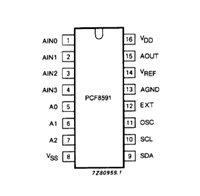HPQ Series
Isolated High Power Quarter Brick DC/DC Converters
Sense Input
temperature (See Performance Specifications), a precision temperature sensor
will power down the unit. When the internal temperature decreases below the
threshold of the temperature sensor, the unit will self start.
Note: The sense and VOUT lines are internally connected through low-value re-
sistors. Nevertheless, if sense is not used for remote regulation, the user must
connect + sense to + VOUT and -sense to -VOUT at the converter pins. Sense is
intended to correct small output accuracy errors caused by the resistive ohmic
drop in output wiring as output current increases. This output drop (the differ-
ence between Sense and VOUT when measured at the converter) should not be
allowed to exceed 0.5V.
Output Overvoltage Protection
The output voltage is monitored for an overvoltage condition via magnetic coupling
to the primary side. If the output voltage rises to a fault condition, which could be
damaging to the load circuitry (see Performance Specifications), the sensing cir-
cuitry will power down the PWM controller causing the output voltage to decrease.
Following a time-out period the PWM will restart, causing the output voltage to
ramp to its appropriate value. If the fault condition persists, and the output volt-
ages again climb to excessive levels, the overvoltage circuitry will initiate another
shutdown cycle. This on/off cycling is referred to as “hiccup” mode.
Sense is connected at the load and corrects for resistive errors only. Be careful
where it is connected. Any long, distributed wiring and/or significant inductance
introduced into the Sense control loop can adversely affect overall system stabil-
ity. If in doubt, test the application, and observe the DC/DC’s output transient
response during step loads. There should be no appreciable ringing or oscilla-
tion. You may also adjust the output trim slightly to compensate for voltage loss
in any external filter elements. Do not exceed maximum power ratings.
Input Reverse-Polarity Protection
If the input-voltage polarity is accidentally reversed, an internal diode will be-
come forward biased and likely draw excessive current from the power source.
If the source is not current limited or the circuit appropriately fused, it could
cause permanent damage to the converter.
Current Limiting
When power demands from the output falls within the current limit inception
range for the rated output current, the DC/DC converter will go into a current
limiting mode. In this condition the output voltage will decrease proportionately
with increases in output current, thereby maintaining a somewhat constant power
dissipation. This is commonly referred to as power limiting. Current limit inception
is defined as the point where the full-power output voltage falls below the specified
tolerance. If the load current being drawn from the converter is significant enough,
the unit will go into a short circuit condition. See “Short Circuit Condition.”
Input Fusing
Certain applications and/or safety agencies may require the installation of
fuses at the inputs of power conversion components. Fuses should also be
used if the possibility of a sustained, non-current-limited, input-voltage polarity
reversal exists. For these converters, slow-blow fuses are recommended with
values no greater than twice the maximum input current.
Short Circuit Condition
Trimming Output Voltage
When a converter is in current limit mode the output voltages will drop as the
output current demand increases. If the output voltage drops too low, the mag-
netically coupled voltage used to develop primary side voltages will also drop,
thereby shutting down the PWM controller. Following the specified time-out
period, the PWM will restart, causing the output voltages to begin ramping to their
appropriate values. If the short-circuit condition persists, another shutdown
cycle will be initiated. This on/off cycling is referred to as “hiccup” mode. The
hiccup cycling reduces the average output current, thereby preventing internal
temperatures from rising to excessive levels. This converter is capable of
enduring an indefinite short circuit output condition.
These converters have a trim capability that enables users to adjust the output
voltage over a limited range (refer to the trim equations). Adjustments to the out-
put voltage can be accomplished with a single fixed resistor as shown in Figures
5 and 6. A single fixed resistor can increase or decrease the output voltage
depending on its connection. Resistors should be located close to the converter
and have TCR’s less than 100ppm/°C to minimize sensitivity to changes in
temperature. If the trim function is not used, leave the trim pin open.
Standard units have a “positive trim” where a single resistor connected from
the Trim pin to the +Sense will increase the output voltage. A resistor con-
nected from the Trim Pin to the –Sense will decrease the output voltage.
Thermal Shutdown
Trim adjustments greater than the specified trim range can have an adverse
affect on the converter’s performance and are not recommended. Excessive
voltage differences between VOUT and Sense, in conjunction with trim adjust-
ment of the output voltage, can cause the overvoltage protection circuitry to
activate (see Performance Specifications for overvoltage limits).
These converters are equipped with thermal-shutdown circuitry. If the internal
temperature of the DC/DC converter rises above the designed operating
%15)6!,%.4 #)2#5)4 &/2
0/3)4)6% !.$ .%'!4)6%
,/')# -/$%,3
ꢃꢄ6
ꢃ).054
ꢂ
ꢀ
Temperature/power derating is based on maximum output current and voltage
at the converter’s output pins. Use of the trim and sense functions can cause
output voltages to increase, thereby increasing output power beyond the
converter’s specified rating, or cause output voltages to climb into the output
overvoltage region. Therefore:
/.ꢅ/&&
#/.42/,
#/.42/,
(VOUT at pins) x (IOUT) ꢀ rated output power
2%&
ꢁ
n).054
#/--/.
The Trim pin is a relatively high impedance node that can be susceptible to
noise pickup when connected to long conductors in noisy environments.
Figure 4. Driving the Remote On/Off Control Pin
www.murata-ps.com
Technical enquiries email: sales@murata-ps.com, tel: +1 508 339 3000
MDC_HPQ Series.A07 Page 7 of 10






 STM32F030C6芯片介绍:主要参数分析、引脚配置说明、功耗及封装
STM32F030C6芯片介绍:主要参数分析、引脚配置说明、功耗及封装

 PCF8591数据手册解读:参数、引脚说明
PCF8591数据手册解读:参数、引脚说明

 一文带你了解ss8050参数、引脚配置、应用指南
一文带你了解ss8050参数、引脚配置、应用指南

 深入解析AD7606高性能多通道模数转换器:资料手册参数分析
深入解析AD7606高性能多通道模数转换器:资料手册参数分析
